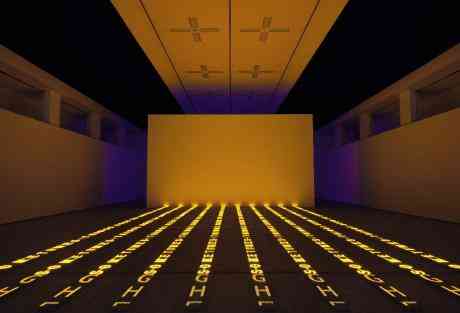By Andrew Graham-Dixon 355PM GMT nineteen March 2010
 A web of difference Jenny Holzer?s pleasant designation "For Chicago"
A web of difference Jenny Holzer?s pleasant designation "For Chicago" "The commencement of the fight will be secret", threatens a outrageous ensign on the side of the red-brick Baltic in Gateshead. It is the origination of American artist Jenny Holzer, whose unchanging element includes threats, provocations, manifestos, truisms and all sorts of sinister insinuations.
Henry Moore at Tate Britain Christen Kobke at the National Gallery "There"s nowhere to kick it" Yoko Ono - is her art any good? Anthony dOffay Artist Rooms, examination 1989 the key dates in the tumble of communismHolzer has been operative with difference for thirty years, carrying initial voiced herself with a form of statements flyposted onto buildings in New York in the late 1970s "Abuse of Power Comes as No Surprise"; "Money Creates Taste"; "Torture is Barbaric".
Inserted in to the mainstream of city signage, these puzzling texts were meant to allow an obscure pick to the messages of the big media, such as the slogans of promotion or the flashing LED displays and scaled-up neon imagery of Times Square. Holzer"s "Truisms", as she called them, were there to stitch disbelief and distrust in the mind of the beholder.
Holzer has her detractors, particularly the former art censor of Time magazine, Robert Hughes, who once likened her to a 17th-century New England mama sewing righteous platitudes onto samplers. But Holzer is clever to keep a area from her work. None of her proclamations is to be taken to demonstrate her own beliefs. The opposing signals offer as a sign that the universe is never as elementary as those with something to sell be it a product or a believe similar to to have out.
Now in her 60th year, Holzer is one of the majority respected, sought-after artists of her generation, so her new show at Baltic is a manoeuvre for the North East. Occupying dual floors, this is by a little area the largest muster of the artist"s work to have been seen in Britain, and extremely the richest.
It opens with a fantastic ground-level LED designation For Chicago, that plunges the spectator in to a sea of words, call after call of them, shifting opposite the building usually to vanish as they strike the finish wall of the gallery. The cycle, that runs for the most appropriate square of a day, encompasses some-more or less each content Holzer wrote in between 1977 and 2001, so the square itself is a kind of mini-retrospective, pleasant and bewildering by turns.
Many voices are parodied in the texts of the "Truisms", either that of the lover, murderer, statesman or preacher. But the exactly effect, whilst dizzying, is puzzling and cool. The artist stays veiled, inscrutable, dark inside of her own web of words.
But the mood shortly changes. During the past fifteen years Holzer has turn extremely some-more politically engaged. Much of the concentration in this new show is on her some-more new work, so that from the relations patience of For Chicago the caller moves to a work such as Lustmord, that was combined in the mid-1990s, in proceed reply to the counsel and vital make use of of rape as a tactic during the fight in the former Yugoslavia.
It is not for the faint-hearted. Two tables take up the floor, each one lonesome with an form of human skeleton (sourced not from the dispute itself but from anatomists" suppliers in America). The skeleton are ringed with tags, each one stamped with a bit of content formed on the declare statements of victims, perpetrators and UN observers. "She has 3 colours in her eyes" is one example, taken from the chilling comment of a assailant objectifying his prey.
Lustmord is a chilling and horrible piece, that stays something of an difference to the rest of Holzer"s work, but in examination it does appear to have noted a change in her approach. In new years, angry by the wars in Afghanistan and Iraq and the diagnosis of detainees at Guantanamo Bay, she has deserted essay her own texts exactly and taken to operative without delay with declassified papers detailing US impasse in the Middle East.
Enlarged and eliminated to canvas, these sinister difference and diagrams have a sheer reality about them. They are as important for the vacant areas of blank or redacted content as they are for the difference that have been left visible. In one case, the complete board is a mass of black erasure, with usually the singular word "waterboarding" left legible.
The total form is similar to a Conceptualist"s version of Goya"s Disasters of War, whilst the waterboarding portrayal resembles a disfigured 21st-century version of Malevich"s Black Square but with Malevich"s space of insubordinate probability emptied of all optimism, remade in to the picture of a really opposite form of amicable transformation. It creates for a strenuously distressed finish to an unsettling exhibition.
This examination additionally appears in Seven magazine, free with The Sunday
0 comments:
Post a Comment